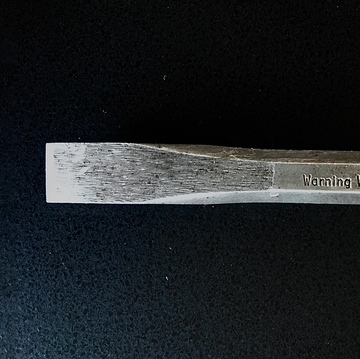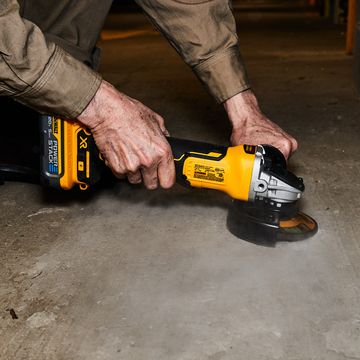With winter just around the corner, now’s the time to seal up drafty windows to prevent cold winds from blowing into your home. Weather-tight windows will not only make your home feel more comfortable, but also they’ll save you money each month by reducing energy consumption, resulting in lower heating bills.
And while there are several ways to seal any drafty windows in your home, the best approach requires a two-pronged attack: caulking around the outside of the window and weather stripping the inside. Here’s a guide on how to nail this process.
Caulking
Begin by scraping off any old caulk or peeling paint from around the exterior perimeter of the window. You could use a regular metal putty knife to scrape the surface clean, but a much better option is a 6-in-1 painter’s tool. This specialty tool has stiff, beveled scraping blade and pointed tip that’s great for raking hardened caulk out of narrow cracks and crevices. And if the beveled end becomes dull or damaged, you can always sharpen it with a bench grinder.
Once you’ve removed all the old caulk and peeling paint, clean away all dirt and dust using a scrub brush dipped in warm, soapy water. Then, wipe the surface dry with an old towel. Next, apply a fresh bead of caulk around the outside perimeter of the window, creating a continuous wind-blocking seal between the window frame and siding, or between the window frame and exterior trim boards. And be sure to use an exterior-grade caulk. I recommend either 100% silicone sealant or a “siliconized” acrylic caulk. Both adhere well and will remain flexible for years. Note, however, that 100% silicone must be cleaned up with mineral spirits; siliconized caulk can be cleaned with water.
Weather Stripping
After caulking around the outside of the window, move inside and use weather stripping to seal around the sash. (The sashes are the movable parts of a window that open and close.) There are dozens of different styles of weather stripping available for sealing windows, but these are top five types:
Adhesive-backed foam: This is a compression type of weather stripping, meaning that when the window closes against it, the foam compresses to seal gaps and block drafts. It features easy peel-and-stick application and cuts with scissors. Just be sure to thoroughly clean the area around the inside of the window, as the adhesive won’t stick to dusty, dirty surfaces. On double-hung windows, apply adhesive-backed foam weather stripping to the bottom edge of the lower sash, and to the top edge of the upper sash. If you don’t want to apply the weather stripping to the sash, stick it to the sill directly below the lower sash, and to the head jamb above the upper sash. Either way, once the sash is closed and locked, the foam will seal out drafts. On sliding or casement windows, apply the adhesive-backed foam to the vertical edge of the sash or vertically along the side jamb.
Tubular rubber-gasket weather stripping: This is similar to adhesive-backed foam, except that it’s formed into a hollow rubber tube instead of dense foam. When compressed by the sash, the tubular weather stripping conforms to the space, effectively sealing out drafts. Some tubular gaskets have peel-and-stick adhesive backing, while others have an attached metal or wood flange that must be secured with nails or screws. Also look for foam-filled tubular gaskets that have a spongy-foam core, which holds its shape better than the hollow-core gaskets.
Spring V-Seal: This is a resilient polypropylene plastic or metal strip that comes folded into a V-shape. It’s known as tension-seal weather stripping because the V-shape springs open, creating tension between the sash and window frame that blocks the passage of air. Plastic V-seal can be cut with scissors, but you’ll need aviation snips to cut metal V-seal, which comes in copper, aluminum, bronze, and stainless steel. Also, the plastic type often has a peel-and-stick backing, while metal V-seal must be nailed in place. V-seal can be installed vertically along the sides of double-hung windows, and at the horizontal meeting rail where the two sashes meet when closed. On casement or sliding windows, V-seal is installed along the vertical side jamb where the sash closes.
Felt: Felt is one of the oldest types of weather stripping. It’s commonly sold in rolls with or without an adhesive backing and is also available with an attached metal mounting flange. Felt is used as a compression weather stripping around the inside of double-hung, casement, and sliding windows. Felt is affordable and easy to install, but it doesn't last as long as other types of weather stripping and must be replaced every four to six years.
Window insulation kits: These kits block cold air by sealing the entire window behind a large sheet of shrink-wrap plastic. The plastic adheres to the interior window casing with double-sided tape; you then use a blow dryer to seal it in place. Window insulation kits are very effective at sealing out drafts, but keep in mind that you won’t be able to open the window until next spring, when you peel off the plastic wrap.
Here’s one final tip for sealing drafty double-hung windows. Most of them have a single sash lock installed at the horizontal meeting rails where the upper and lower sash meet. To ensure that the two sashes fit tightly together, add a second sash lock: Unscrew the existing sash lock and reinstall it about one-third of the way in from the side jamb. For example, if the window is 24 inches wide, move the sash lock from the middle of the sash to about 8 inches from the end. Next, buy a second sash lock and install it 8 inches in from the opposite side jamb. Now, when you engage both locks, the sashes will fit together tightly.
Joe is a former carpenter and cabinetmaker who writes extensively about remodeling, woodworking, and tool techniques. He has written eight books and is a contributing editor to Popular Mechanics. He also appears on the Today’s Homeowner TV show, and co-hosts the weekly Today’s Homeowner Radio Show. Joe writes from his home in Roxbury, Connecticut.

















